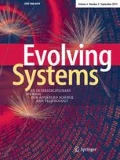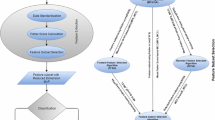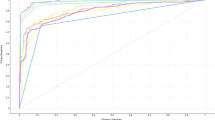Abstract
Today’s food habits, way of life causes a number of health disorders in human especially those related to heart diseases. Cardiac arrest is one such disease, which is the deadliest form is Myocardial Infarction (MI). Earlier prediction of MI would save the viability of human. This study presents a new approach in analyzing the history of patients related to heart disorders. A new feature selection and feature ranking approach is proposed to filter the high preferential features that help in early detection of MI. As the contribution capacity of different features varies in proportion, a varying combination of feature (VCF) algorithm is proposed and probabilistic principal component analysis (PPCA) is implemented to improve the feature extraction. The projected feature vectors are analyzed with respect to their covariance and the vectors with highest covariance is identified by PPCA. Thus, the VCF and PPCA reduces the dimensionality of the dataset overcoming the curse of dimensionality issue. The selected prominent features are subjected to multi-linear regression (MLR) and those combinations that are tightly related are identified. Further they are passed through radial basis function (RBF) based support vector machines (SVM) for classification. The two classes generated by SVM includes patients with and without MI. The clinical tests of patients are taken as dataset for analysis and the performance of the system is measured. The predicted patients and the mortality rate are correlated to measure the system performance. The combination of these machine learning algorithms with the chosen manifestations identifies the myocardial forecasts. The results demonstrates that the planned framework fits for predicting the MIs.



Similar content being viewed by others
Availability of data and material
The relevant data and material towards the work are available with authors.
Code availability
The relevant code towards the work are available with authors.
References
Afifi S, GholamHosseini H, Sinha R (2019) A system on chip for melanoma detection using FPGA-based SVM classifier. Microprocess Microsyst 65:57–68
Angelov P, Gu X, Kangin D (2017) Empirical data analytics. Int J Intell Syst 32(12):1261–1284
Angelov P, Zhou X (2008) On line learning fuzzy rule-based system structure from data streams. In: 2008 IEEE International Conference on Fuzzy Systems (IEEE World Congress on Computational Intelligence). IEEE, pp 915–922
Babaoğlu I, Fındık O, Bayrak M (2010) Effects of principle component analysis on assessment of coronary artery diseases using support vector machine. Expert Syst Appl 37(3):2182–2185
Baral S, Alsadoon A, Prasad PWC, Al Aloussi S, Alsadoon OH (2021) A novel solution of using deep learning for early prediction cardiac arrest in Sepsis patient: enhanced bidirectional long short-term memory (LSTM). Multimedia Tools Appl:1–26
Chae M, Han S, Gil H, Cho N, Lee H (2021) Prediction of in-hospital cardiac arrest using shallow and deep learning. Diagnostics 11(7):1255
Duchateau N, De Craene M, Allain P, Saloux E, Sermesant M (2016) Infarct localization from myocardial deformation: prediction and uncertainty quantification by regression from a low-dimensional space. IEEE Trans Med Imaging 35(10):2340–2352
Elmaizi A, Nhaila H, Sarhrouni E, Hammouch A, Nacir C (2019) A novel information gain based approach for classification and dimensionality reduction of hyperspectral images. Procedia Comput Sci 148:126–134
Ibrahim L, Mesinovic M, Yang KW, Eid MA (2020) Explainable prediction of acute myocardial infarction using machine learning and shapley values. IEEE Access 8:210410–210417
Jolliffe IT (2002) Principal component analysis, 2nd edn. Springer, New York
Khaing HW (2011) Data mining based fragmentation and prediction of medical data. In: 2011 3rd International Conference on Computer Research and Development, vol 2. IEEE, pp 480–485
Kim DK, Kim NS (2001) Rapid speaker adaptation using probabilistic principal component analysis. IEEE Signal Process Lett 8(6):180–183
Lee PY, Loh WP, Chin JF (2017) Feature selection in multimedia: the state-of-the-art review. Image vis Comput 67:29–42
Lee S, Lee H, Kim HS, Koh SB (2020) Incidence, risk factors, and prediction of myocardial infarction and stroke in farmers: A Korean nationwide population-based study. J Prev Med Public Health 53(5):313
Mustaqeem A, Anwar SM, Khan AR, Majid M (2017) A statistical analysis based recommender model for heart disease patients. Int J Med Inf 108:134–145
Pattekari SA, Parveen A (2012) Prediction system for heart disease using Naïve Bayes. Int J Adv Comput Math Sci 3(3):290–294
Peter TJ, Somasundaram K (2012) An empirical study on prediction of heart disease using classification data mining techniques. In: IEEE-International conference on advances in engineering, science and management (ICAESM-2012). IEEE, pp 514–518
Ramasamy S, Sulthana AR (2018) KEB173—recommender system. Knowledge computing and its applications. Springer, Singapore, pp 235–260
Schölkopf B, Smola AJ, Bach F (2002) Learning with kernels: support vector machines, regularization, optimization, and beyond. MIT Press, Cambridge
Sharma N, Saroha K (2015) A novel dimensionality reduction method for cancer dataset using PCA and feature ranking. In: 2015 International Conference on Advances in Computing, Communications and Informatics (ICACCI). IEEE, pp 2261–2264
Shouman M, Turner T, Stocker R (2012) Using data mining techniques in heart disease diagnosis and treatment. In: 2012 Japan-Egypt Conference on Electronics, Communications and Computers. IEEE, pp 173–177
Stensjøen AL, Hommerstad A, Halvorsen S, Arheden H, Engblom H, Erlinge D, Larsen AI, Sejersten Ripa M, Clemmensen P, Atar D, Hall TS (2020) Worst lead ST deviation and resolution of ST elevation at one hour for prediction of myocardial salvage, infarct size, and microvascular obstruction in patients with ST‐elevation myocardial infarction treated with primary percutaneous coronary intervention. Ann Noninvasive Electrocardiol 25(6):e12784
Sulthana AR, Ramasamy S (2019) Ontology and context based recommendation system using neuro-fuzzy classification. Comput Electr Eng 74:498–510
Sulthana AR, Gupta M, Subramanian S, Mirza S (2020) Improvising the performance of image-based recommendation system using convolution neural networks and deep learning. Soft Comput 19:14531–14544
Takci H (2018) Improvement of heart attack prediction by the feature selection methods. Turk J Electr Eng Comput Sci 26(1):1–10
Tay D, Poh CL, Van Reeth E, Kitney RI (2014) The effect of sample age and prediction resolution on myocardial infarction risk prediction. IEEE J Biomed Health Inform 19(3):1178–1185
Tomaszewski JE, Hipp J, Tangrea M, Madabhushi A (2014) Machine vision and machine learning in digital pathology
Wang S, Li Y, Shao Y, Cattani C, Zhang Y, Du S (2017) Detection of dendritic spines using wavelet packet entropy and fuzzy support vector machine. CNS Neurol Disord Drug Targets 16(2):116–121
Yao J, Xie Y, Liu Y, Tang Y, Xu J (2020) Prediction factors of 6-month poor prognosis in acute myocardial infarction patients. Front Cardiovasc Med 7:130
Zhang YD, Wu L (2012) An MR brain images classifier via principal component analysis and kernel support vector machine. Progr Electromagn Res 130:369–388
Zhang Z, Dong J, Luo X, Choi KS, Wu X (2014) Heartbeat classification using disease-specific feature selection. Comput Biol Med 46:79–89
Zhang J, Lafta RL, Tao X, Li Y, Chen F, Luo Y, Zhu X (2017) Coupling a fast fourier transformation with a machine learning ensemble model to support recommendations for heart disease patients in a telehealth environment. IEEE Access 5:10674–10685
Zheng Y, Jiang Z, Xie F, Zhang H, Ma Y, Shi H, Zhao Y (2017) Feature extraction from histopathological images based on nucleus-guided convolutional neural network for breast lesion classification. Pattern Recogn 71:14–25
Zhou X, Angelov P (2007) Autonomous visual self-localization in completely unknown environment using evolving fuzzy rule-based classifier. In: 2007 IEEE symposium on computational intelligence in security and defense applications. IEEE, pp 131–138
Funding
Not applicable.
Author information
Authors and Affiliations
Contributions
Both the authors have equally contributed to the work.
Corresponding author
Ethics declarations
Conflict of interest
There is no conflict of interest with any firm or person.
Ethics approval
The manuscript has not been submitted to any other journal nor a part of the work is published anywhere.
Consent for publication
The authors would be ready for publication if this article is accepted by journal.
Additional information
Publisher's Note
Springer Nature remains neutral with regard to jurisdictional claims in published maps and institutional affiliations.
Appendix
Appendix
Variables | Description | Variables | Description |
|---|---|---|---|
AGE | Age in years | LVEF (%) | Left ventricular ejection fraction |
(LVEF: ≥ 55%) High mortality | |||
(LVEF: < 55%)Low mortality | |||
SEX | Male-M | TC | Total cholesterol |
Female-F | Normal Range > 160 mg/dL | ||
Abnormal Range > or = 200 mg/dL | |||
Ht(m) | Hyper tension levels | HDL | High density lipoprotein |
Normal range = 1.2–1.5 | < 40 mg/dL may be an effective warning sign for atherosclerotic development | ||
Abnormal range > 1.5 | > 40 less chances or mortality | ||
Wt(kg) | Weight in kilograms | VLDL5 | Very low-density lipoprotein |
Range = 25 to 50 are associated with increased coronary heart disease | |||
BMI | Body Mass Index | LDL | Low density lipoprotein |
Both male and female | Young adults experiencing acute MIs typically have acceptable cholesterol levels (i.e., < or = 130 mg/dL) or optimal values (ie, < or = 100 mg/dL) | ||
Normal BMI -18.5–24.9 | |||
Abnormal range < 18.5 and > 24.9 | |||
HEART RATE | Range | TGL | Triglyceride |
Normal < 80 beats per minute | High Serum Triglyceride Concentration Is a Cause Of The Incidence Of MI | ||
Abnormal > 80 beats per minute | |||
SBP | Systolic blood pressure | UREA | > or = 25 mg/dL -High Mortality rate |
Normal range 130–139 | |||
DBP | Diastolic blood pressure | CREAT | Creatinine |
Normal range 85–89 | “(Elevated group, serum creatinine > or = 1.3 mg/dl), and 2) normal serum creatinine group (normal group, serum creatinine < 1.3 mg/dl)” | ||
DM FOR SPSS | Diabetes mellitus history | HB | Haemoglobin levels |
Yes = 1 | “The mortality was 21.6% in patients with haemoglobin levels on admission < or = 10 g/dl and 9.3% in patients with haemoglobin levels > 10 g/dl (p < 0.001).” | ||
No = 2 | |||
HT FPR SPSS | Hyper tension | Total count | White blood cells |
Yes = 1 | “Median WBC peak was 11 395/mm3 (range 3100–26,900); median neutrophils peak was 8345/mm3 (range 3770–22,600), median monocytes peak was 890/mm3 (range 280–2400), and median lymphocytes peak was 2400/mm3 (range 300–12,730)” | ||
No = 2 |
Rights and permissions
About this article
Cite this article
Sulthana, A.R., Jaithunbi, A.K. Varying combination of feature extraction and modified support vector machines based prediction of myocardial infarction. Evolving Systems 13, 777–794 (2022). https://doi.org/10.1007/s12530-021-09410-4
Received:
Accepted:
Published:
Issue Date:
DOI: https://doi.org/10.1007/s12530-021-09410-4




